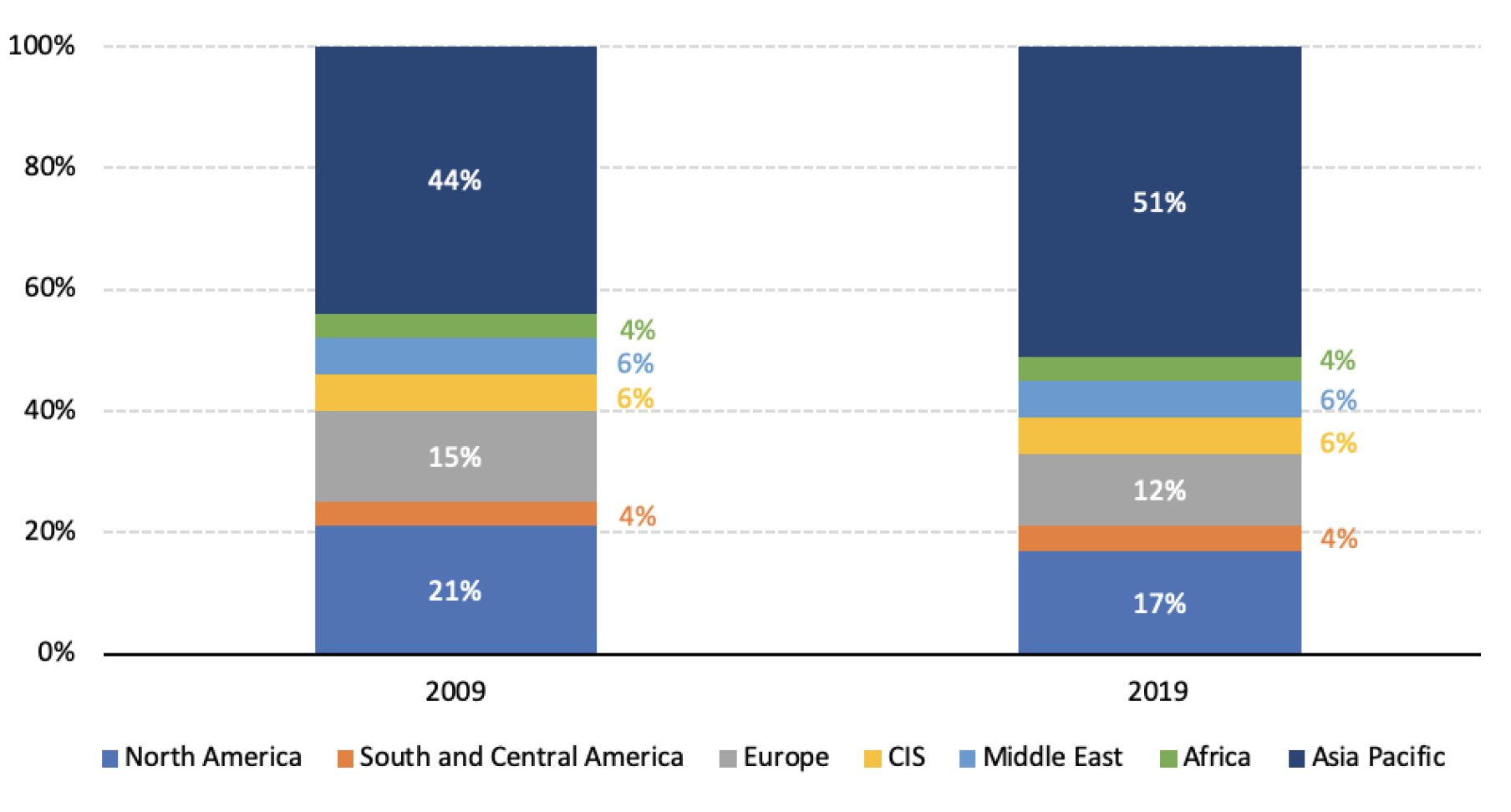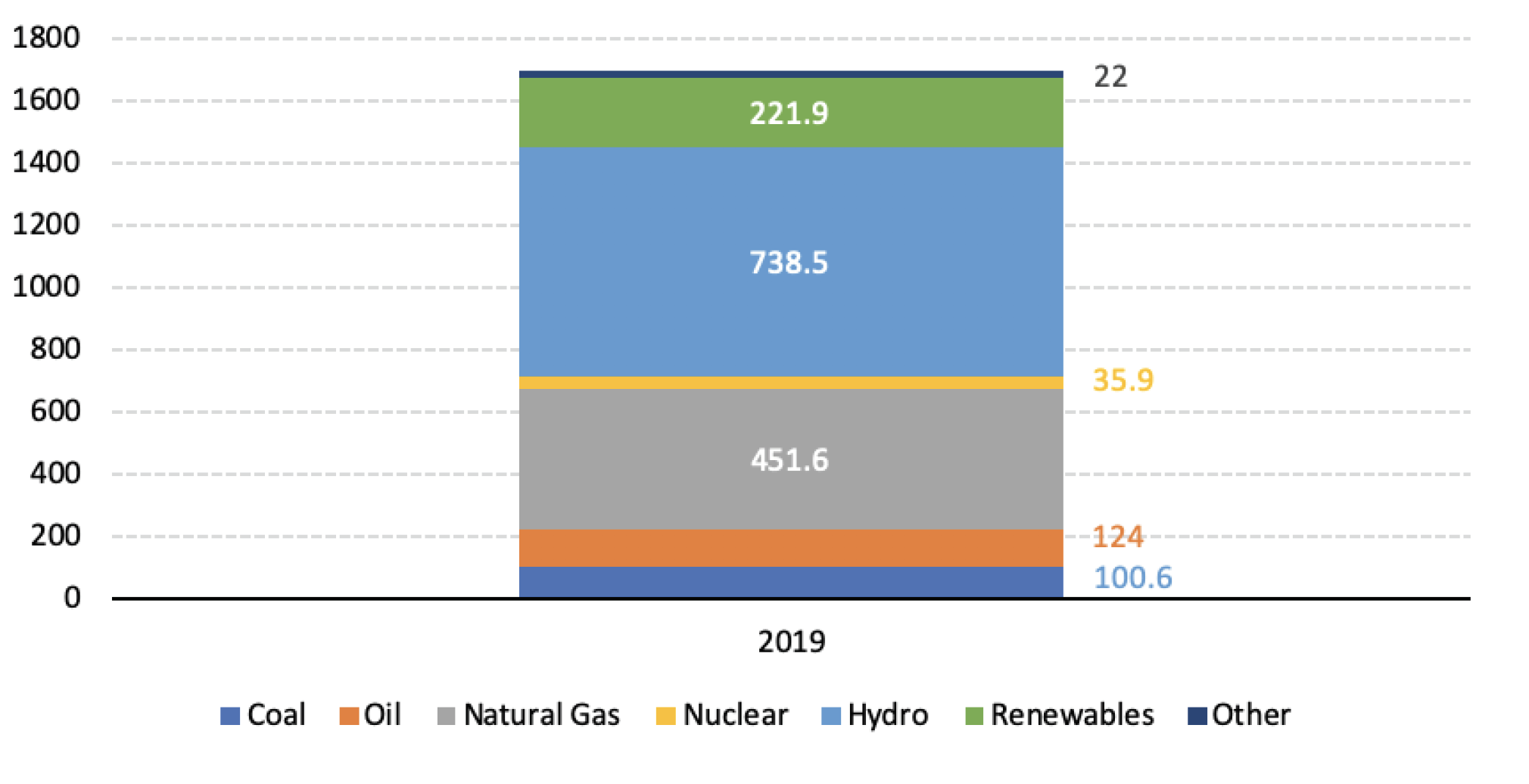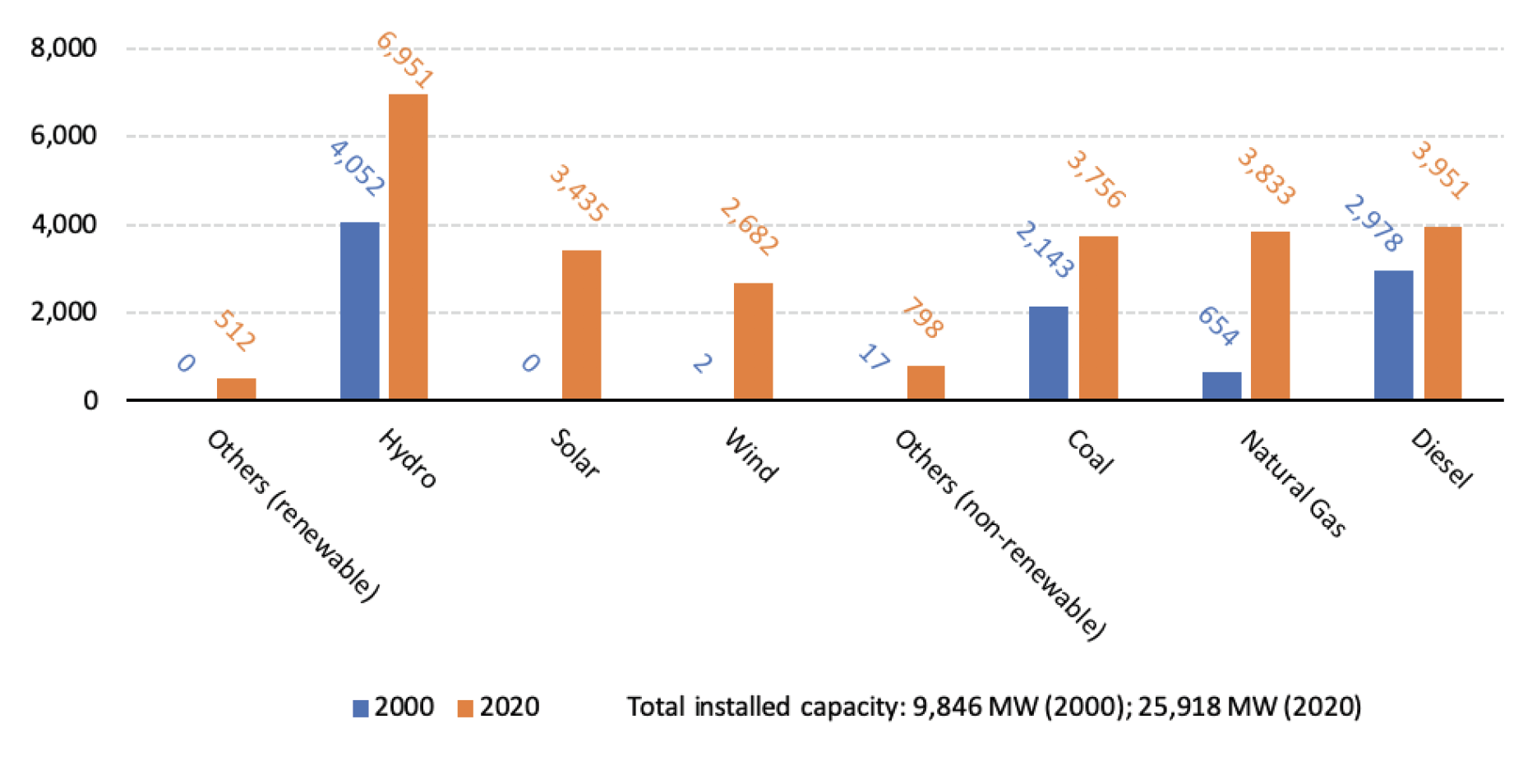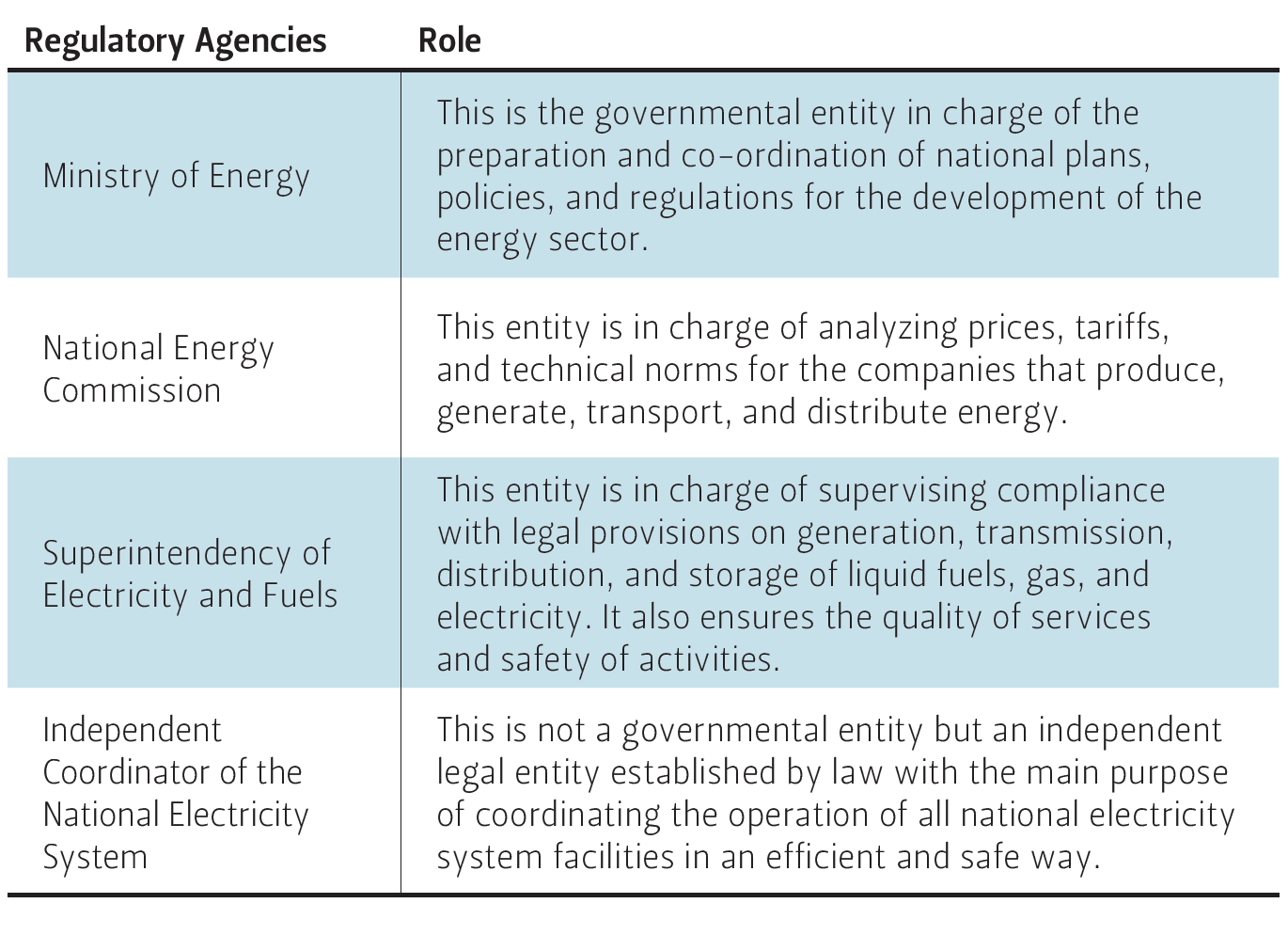Green Hydrogen and Chile’s Energy Transition

Table of Contents
Author(s)
Share this Publication
- Download PDF
- Print This Publication
- Cite This Publication Copy Citation
Leiss, Benigna C. 2021. Chile’s Energy Transition and the Role of Green Hydrogen. Issue brief no. 04.23.21. Rice University’s Baker Institute for Public Policy, Houston, Texas.
Chile has negligible reserves of oil, natural gas, and coal and is therefore primarily a net importer of energy. Given its minimal role in global energy markets, Chile does not usually come to mind as a country that could become a major player in the global energy transition. However, because of the abundance of sun and wind available for power generation, Chile could become an energy exporter, not of electricity, but of green hydrogen, made possible by its cheap renewable power sources. Since the 2015 Paris Agreement, countries around the world have committed to reducing their carbon emissions, with the ultimate objective of slowing global warming and the effects of climate change. Green hydrogen, which is produced using renewable energy and electrolysis to split water molecules, can be burned as a fuel without producing carbon dioxide (CO2) or other greenhouse gases. Because of this, it is an attractive energy alternative being considered to aid in the global energy transition.
As a potential producer and exporter of green hydrogen, Chile is now at the forefront of not only Latin America’s energy transition, but also that of the world. This is despite representing a relatively small share of global primary energy consumption and greenhouse gas emissions (0.3% in both categories), while Latin America as a whole represents 6% and 4%, respectively (Figure 1). Chile’s real impact in the energy transition will not depend on the level or structure of its own energy consumption, but on the country’s ability to use its solar and wind resources to produce and export large amounts of green hydrogen.
Latin America is already at the forefront of using renewable energy, generating over half of its electricity from renewables (Figure 2). As shown in Figure 3, Chile has aggressively developed its generation capacity for solar and wind power in the last 20 years. The country’s growth in this area was primarily driven by renewables. Solar and wind added more than 3,435 megawatts (MW) and 2,682 MW of energy generation, respectively. In 2020, this represented close to 25% of the existing installed capacity.
The transformation of Chile’s energy sector, which has involved changing the power generation mix to incorporate solar and wind power, has been the result of collaboration between the public and private sectors. Private participation has been allowed in the country since the late 1980s, when the legal and regulatory frameworks were put in place for electricity generation, transmission, and distribution. Since the early 2000s, transmission has been unbundled from the other two segments (see Table 1).
As highlighted in Table 2, Chile has attracted local and international companies to participate in the generation, transmission, and distribution segments of the electric sector. Not only is Chile one of the best-positioned countries to lead in the development of low-carbon energy, but it also stands to profit significantly going forward. First, the country possesses major reserves and is one of the top producers of critical metals such as lithium and copper, which are indispensable for the manufacturing of electric cars and batteries. In addition, given the quality of its solar radiation in the northern region and onshore wind in the extreme south, Chile is well positioned to generate some of the cheapest solar and wind power in volumes that exceed its energy demand. Because of this, Chile hopes to produce more green hydrogen that could effectively be stored as renewable energy for efficient use in the country’s energy-intensive mining industry and could become a valuable export commodity as the world looks for greener fuels and turns away from CO2-intensive fossil fuels.
Figure 1 — Total CO2 Emissions by Region

Note CIS = Commonwealth of Independent States
Figure 2 — Power Generation by Fuel Source in Latin America, 2019 (in Terrawatt Hours)

Green Hydrogen
Chile’s green hydrogen strategy is based squarely on its abundance of renewable resources. The country’s potential for solar and wind generation has been estimated at about 1,800 gigawatts (GW) with a levelized cost of electricity (LCOE) below $35 per megawatt hour (MWh).1 For comparison, in 2019, total worldwide installed wind capacity was 622 GW wit a global weighted average LCOE of $53/MWh (onshore) and $115/MWh offshore.2 The total installed global solar photovoltaics capacity was at 580 GW with a global weighted average LCOE of $68/MWh.3
Given the low cost and abundance of renewable energy, Chile is in a good position to produce the cheapest hydrogen on the planet. Chile’s National Green Hydrogen Strategy embraces this potential and sets a goal for the nation to become a major green hydrogen producer an exporter by 2035.4 The strategy estimates
that Chile’s 2030 hydrogen production cost will be at $1.40 per kilogram (kg),5 which is well below the $2.0-$2.5/kg6 estimated to be needed for hydrogen to become a viable alternative to fossil fuels by 2030 and, notably, below the $1.50/kg recently announced by Saudi Arabia7 as one of the lowest costs in the world.
Joint participation of the public and private sectors is critical for the success of this strategy. Companies, investors, and international agencies have already become involved in supporting studies as well as pilot projects to test the viability of producing hydrogen, ammonia, and green methanol. Once the production is proven viable, developing the necessary infrastructure and establishing markets are the next essential steps.
The National Green Hydrogen Strategy proposes three waves of development to expand green hydrogen production and use by increasing demand:
- The first wave (2020-2025) is aimed at incentivizing domestic production a replacing domestic energy-intensive processes. An example is replacing imported ammonia and grey hydrogen used in local refineries and using green hydrogen “for heavy and long-distance transportation."
- The second wave (2025-2030) is focused on creating and growing an export market for green ammonia produced using green hydrogen. This stage includes encouraging investment and offtake commitments. Ammonia is used primarily as a fertilizer in the agricultural sector as well as in the manufacturing of plastics, explosives, and chemicals.
- The third wave (2030+) is described as expanding production in order to become a “global supplier of clean fuels.”8
Figure 3 — Chile’s Overall Installed Capacity by Source, 2000 and 2020 (in MW)

In order to enact this strategy, the Ministry of Energy has identified four main focus areas:
- Develop a system of regulations and permits, streamline the project development process, determine appropriate taxation schemes to encourage carbon neutrality, and define legislation for green hydrogen aimed at promoting demand.
- Establish ways to finance and incentivize green energy projects. This would involve closing cost gaps, offering incentives for the development of early stage projects, establishing channels of financing, and reducing costs for green hydrogen production. All of these steps would help Chilean and international companies and consortia develop “scalable and replicable” local green hydrogen projects.
- Create a domestic market and international partnerships to capture demand and establish Chile as a competitive supplier of green hydrogen. A recent step that Chile has taken to start establishing international demand is signing a memorandum of understanding (MOU) with Singapore for collaboration on low-carbon hydrogen technologies.9
- Generate local value by establishing long-term sustainability and scalability through emphasis on value capture, infrastructure development, and expansion to rural and remote geographic locations. A key step is addressing infrastructure needs for green hydrogen hubs (for export terminals, desalination plants, electric transmission sites, etc.).
Table 1 — Chile’s Regulatory Agencies

Table 2 — Local and International Companies Involved in Chile’s Energy Industry

Since Chile has embraced the strategy to become a producer and exporter of hydrogen by 2030-35, there are more than 20 pilot projects on the drawing board in the country, according to Argus Media, an independent provider of energy and commodity price benchmarks.10
The following are a few of the confirmed projects:
- The pilot project “Haru Oni Plant” in the southern tip of Chile has an objective to create synthetic fuel from hydrogen produced with wind power. The participants include a Chilean company called Highly Innovative Fuels, a German oil-trading company called Mabanaft, Siemens Energy, Enel Green Power, and Chile's National Oil Company, all of which are working under an MOU.11
- Engie, a French multinational electric utility company, and Enaex, a Chilean explosives manufacturer, are collaborating on a pilot project in northern Antofagasta in order to produce blasting chemical ammonia using green hydrogen produced via 1 GW of solar power. This project is set to launch in 2024.12
- An MOU also exists between the Ministry of Energy in Chile and the Port of Rotterdam Authority. The Port of Rotterdam is setting itself up as a hydrogen hub for Northwest Europe and will be matching Chilean hydrogen supply to demand via its distribution networks to neighboring countries in Europe. The Chilean Minister of Energy “emphasized that the aim of the MOU is part of a plan to ensure the countries work together to pair international supply and demand for hydrogen.”13
Opportunities and Challenges to Chile’s Green Hydrogen Strategy
To get a green hydrogen economy moving, the domestic market is likely to be key. This strategy can further decarbonize Chile’s economy, in particular its mining industry. This translates into decarbonization of the global economy given the importance of lithium for batteries and energy storage, and copper for electric vehicles. Chile is well positioned in this sense, as it can use its abundant renewables to produce hydrogen as a substitute for fossil fuels, including for water desalinization.
One challenge for Chile’s hydrogen future is in exports, since Chile is not near the major markets for hydrogen—including the United States, Europe, and China. Its economic success will depend on the delivered cost of Chilean hydrogen versus home-grown green (or blue) hydrogen in these regions that would not need trans-ocean transport to get to domestic users of hydrogen. Another challenge is that a surge in demand for hydrogen as a fuel depends on the costs of fuel cells in vehicles and new technologies that substitute hydrogen for fossil fuels in heavy industry.
The specifics related to environmental regulations, incentives, tax structures, and building local demand still need to be fleshed out. However, regulation drafts are in the making as mentioned by Argus Media on March 24, 2021.14
Several aspects have not been addressed yet and will require more than Chilean rules and regulation—namely, the need for international commercial and financial arrangements. Investment in hydrogen in Chile will be essential, in addition to ways to ship it to international markets. Technological developments will also be needed to transport the hydrogen in foreign destinations to the end users (e.g., new pipelines or the adaptation of existing pipelines).
This is where commercial and financial arrangements will be critical. In some sense, the development of liquefied natural gas (LNG) as an internationally traded fuel may provide a path forward. In its first decade or so, no one built LNG liquefaction facilities with a hope that demand would be there. There were commercial arrangements that tied sellers and buyers together in long-term, take-or-pay contracts, and those contracts could then be used to finance LNG liquefaction facilities and regasification terminals, the specialized ships needed to transport the LNG, and the power facilities to use the regassified LNG. Similar types of commercial arrangements might be needed for green hydrogen to take off in Chile. In addition, government-to-destination incentives or regulations could be needed t create demand for hydrogen.
Conclusion
Chile has already made major inroads in decarbonizing its domestic economy. Green hydrogen has the potential to become a very attractive option in addressing climate change and pursuing net-zero emissions, but Chile will face many challenges as it attempts to scale up its hydrogen production and become a major player in the energy transition. Chile has embraced developing green hydrogen based on its successful development of solar and wind resources. It has outlined a general strategy to become a leader in producing and exporting competitive green hydrogen with multiple initiatives and proposed projects. However, becoming a major hydrogen exporter requires commercial, financial, and regulatory structures that involve industrial purchasers and users of hydrogen and
governments outside of Chile. These factors will determine what kind of role Chile will play in the global energy transition.
Endnotes
1. National Green Hydrogen Strategy, Ministry of Energy, Government of Chile, November, 2020, https://energia.gob.cl/sites/default/files/national_green_hydrogen_strategy_chile.pdf.
2. IRENA (The International Renewable Energy Agency), Renewable Power Generation Costs in 2019, 2020, https://www.irena.org/publications/2020/Jun/Renewable-Power-Costs-in-2019.
3. Ibid.
4. National Green Hydrogen Strategy, Ministry of Energy, Government of Chile.
5. Ibid.
6. Henry Edwardes-Evans, “Green hydrogen costs need to fall over 50% to be viable: S&P Global Ratings,” S&P Global Platts, November 20, 2020, https://www.spglobal.com/platts/en/market-insights/latest-news/electric-power/112020-green-hydrogen-costs-need-to-fall-over-50-tobe-viable-sampp-global-ratings.
7. “Saudi Arabia Looks to Enter the Green Hydrogen Market With USD$5Bn Plant,” Earth.Org, March 9, 2021, https://earth.org/saudi-arabia-green-hydrogen/.
8. National Green Hydrogen Strategy, Ministry of Energy, Government of Chile.
9. “Singapore And Chile Sign Memorandum of Understanding For Collaboration On Low-Carbon Hydrogen Technologies,” Ministry of Trade and Industry Singapore, Press Release, February 15, 2021, https://www.mti.gov.sg/Newsroom/Press-Releases/2021/02/Singapore-and-Chile-sign-MOU-for-Collaboration-on-Low-Carbon-Hydrogen-Technologies.
10. Patricia Garip, “Chile spearheads green hydrogen strategy,” Argus Media, October 14, 2020, https://www.argusmedia.com/en/news/2150326-chile-spearheads-green-hydrogen-strategy.
11. Bernd Radowitz, “Porsche and Siemens Energy back world’s first green hydrogen-to-e-fuel plant in Chile,” Recharge, December 2, 2020, https://www.rechargenews.com/transition/porsche-and-siemens-energy-backworld-s-first-green-hydrogen-to-e-fuelplant-in-chile/2-1-923389; Al Greenwood, “Chilean firm, Mabanaft sign MoU for green-methanol-to-fuel project,” Independent Commodity Intelligence Services, January 15, 2021, https://www.icis.com/explore/resources/news/2021/01/15/10596348/chilean-firm-mabanaft-sign-mou-for-green-methanol-to-fuel-project.
12. “Engie outlines Chile green hydrogen investment plan,” BNamericas, November 24, 2020, https://www.bnamericas.com/en/news/engie-outlines-chile-green-hydrogen-investment-plan; Garip, “Chile spearheads green hydrogen strategy.”
13. “Ministry of Energy in Chile and Port of Rotterdam Authority sign MOU on green hydrogen,” Comunicaciones Energía, March 17, 2021, https://www.portofrotterdam.com/en/news-and-press-releases/ministry-of-energy-in-chile-and-port-of-rotterdam-authority-sign-mou.
14. Patricia Garip, “Chile advancing green hydrogen regulations,” Argus Media, March 24, 2021, https://www.argusmedia.com/en/news/2199127-chile-advancing-green-hydrogen-regulations?backToResults=true.
This material may be quoted or reproduced without prior permission, provided appropriate credit is given to the author and Rice University’s Baker Institute for Public Policy. The views expressed herein are those of the individual author(s), and do not necessarily represent the views of Rice University’s Baker Institute for Public Policy.



